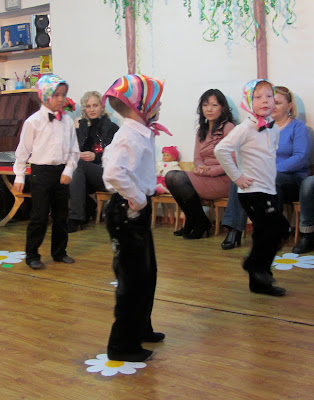While St. Patrick's Day passed without me even realizing it, March is "home" to two other important holidays in Kyrgyzstan. The first is International Women's Day, during which all women and girls receive presents, cards, flowers, chocolate, etc., and no one has to work or go to school. A few days before the 8th, Misha's class put on a Women's Day Program for parents to come and watch - especially for mothers and grandmothers. Misha memorized several short Russian poems to perfection for the big day. The following video shows one of his shining moment singing his lines!
 |
| Looking snazzy in Daddy's bow tie. |
 |
| Singing their hearts out. |
 |
| The boys in the class performed a hilarious "Babushka" ("Grandmother") dance for which they all dressed up like grannies! |
Sebby's class celebrated as well, but not for public viewing. However, I have included this video of him reciting the first stanza of the famous poem "Mishka Kasalapi" - the pigeon-toed bear.
He only misses a few syllables!
Мишка косолапый по лесу идет,
Шишки собирает, песенки поет.
"The pigeon-toed bear walks through the forest,Gathering pinecones, singing a song."
The second holiday in March is Nowruz, an ancient festival welcoming the new year on the vernal equinox. Originally a 3,000-year-old Persian holiday, Nowruz is celebrated today in not only Iran but in Central Asia, the Caucasus, South Asia, and parts of China.
The word Nowruz is an excellent example showing how ancient Sanskrit, modern Persian, and European languages are all members of one huge language family, Indo-European. In modern Persian, now means "new," which relates closely to novus in Latin, nava in Sanskrit, neu in German, and novi in Russian. Ruz is the modern Persian word for "day," however the original Sanskit ruci means "light." Similarly, Latin is lux, and Spanish is luz. So taken together, Nowruz means "new light."
In the Kyrgyzstan's capital, Bishkek, Nowruz is not such a grandly-celebrated holiday. In fact, most of my students told me they spent the days sleeping or staying home. In the villages however, the holiday draws out old traditions - for example, the making of sumuluk (Kyrgyz: сөмөлөк).
Sumuluk is a kind of wheat cereal (kasha) which takes considerable time to prepare and is done as a community event. In the villages, often 10 families get together to make one huge batch of sumuluk. After harvesting the first wheat, the grain must be soaked for ten days. Then it is cooked outside in a huge dish placed in a fire pit. Interestingly, handfuls of small stones are thrown into the bubbling kasha, as the stones prevent it from burning on the bottom. For the next 16 or so hours, the community members take turns stirring the cereal until it's ready to be dished out to everyone in the vicinity. People use their pinky to take the first taste of sumuluk, making a wish in the process. Then people eagerly look for the stones in their portion, lick them off, and toss them into the river. Following another tradition, women who have not yet been able to become pregnant climb into the still-warm fire pit to enjoy the warmth and inspire conditions for a new life this year.
I would have loved to have visited a village for Nowruz, but we had only one day off, so that wasn't possible. However, my Kyrgyz teacher brought me a sample of sumuluk that her neighbors had made for the occasion! It was brown, thick, and sweet. According to my teacher, the word "sumuluk" comes from the old Kyrgyz words suu (water), mul (much) and ak (current), asking "may the river be full" this spring.



1 comment:
Nice video clips! Both Misha and Sebby sound fluent to me! Fun to see.
Post a Comment